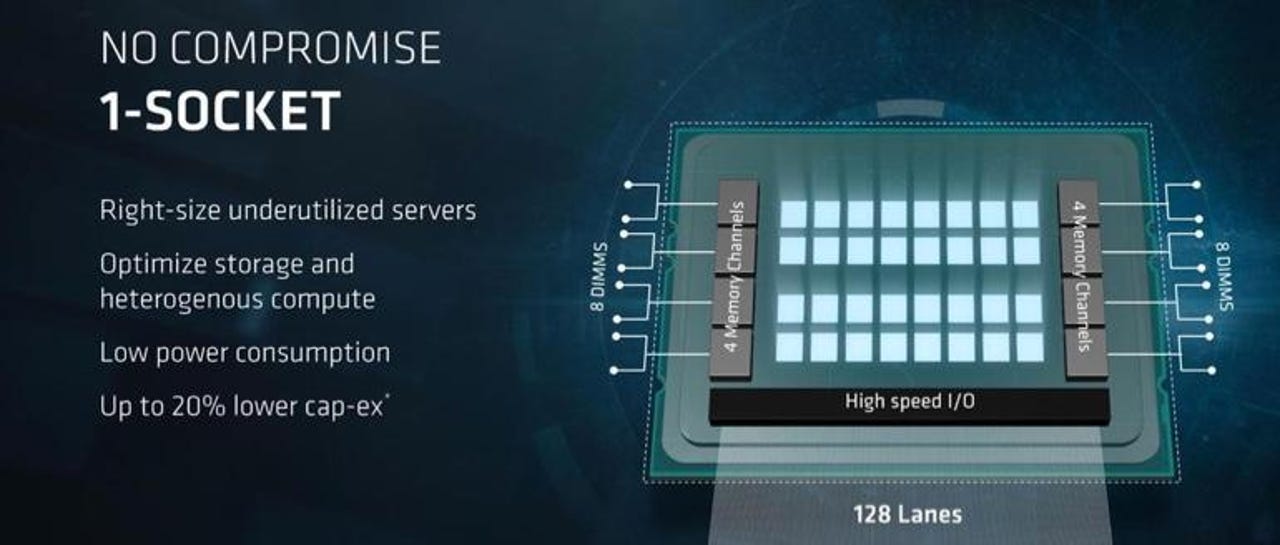Lowering TOC with single-socket AMD EPYC processors


AMD EPYC - No-compromise single-socket processors
One of the most disruptive aspects of AMD's EPYC processors was the company's focus on delivering a no-compromise single-socket processor server solution. And the savings that await companies for some types of workloads are huge.
See also: AMD integrates Ryzen PRO and Radeon Vega graphics in next-generation APUs
Earlier this month I spoke to Raghu Nambiar, AMD's CVP and CTO of Datacenter Ecosystems and Application Engineering, and Dan Bounds, AMD's Senior Director for Data Center Products on the subject of SDS - Software Defined Storage - and how EPYC is well placed to lower TOC in ways previously not possible.
AMD debuts embedded EPYC and Ryzen processors
So what is a "no-compromise single-socket processor server solution"? Put simply, it means that customers don't have to make do with arbitrary limitations when it comes to I/O, or memory bandwidth and performance when they choose single-socket over dual-socket servers, which in turn allows customers to make a no-compromise choice for underutilized servers, and benefit from lower power consumption and lower capital expenditure.
Each EPYC processor package can support up to 2TB of DDR4 RAM over eight channels, and has 128 PCIe lanes, which means that the platform has more than two-and-a-half times the I/O density of a processor such as Intel's Xeon SP Series.
And SDS is an interesting space to consider because it combines all the demands of big data, data analytics, and offline analytics into a single workload.
So what makes EPYC so well suited a solution to the SDS workload? Well, according to Nambiar and Bounds, there are a number of reasons.
Take, for example, how storage and memory are converging in the enterprise space, and EPYC is well placed to take advantage of this. EPYC, with its eight memory channels and 128-lanes of PCI, means that EPYC-powered servers can handle larger memory footprints than those powered by Intel silicon, and there's also a no need to separate PCI switches to be used to take advantage of NVMe storage.
All this allows for greater memory-to-core, and cores-to-spindle/drive ratio in the server room.
Another factor to consider is how the software licensing landscape has changed. For example, VMware vSphere licensing is based on the number of CPUs in a system, and there are special bundles for single-socket systems. And the savings aren't measured in a few dollars, but in thousands of dollars.
According to an April 2018 report by Demartek, for a one-node system, a single-socket server can deliver $7,610 in savings on VMware licensing costs for vSAN and vSphere, while for a three-node cluster, these savings rise to $22,830.
And these savings are simply as a result of switching from dual-socket to single-socket. That's it.
AMD's EPYC: Everything you need to know
And these figures don't include savings that come from reduced power consumption and lowered cooling costs.
I also talked with Nambiar and Bounds about what the future has to offer, and it's clear that there are a lot of changes coming. Here are a few things that are on the server horizon:
- Multi-chip modules will bring greater flexibility, especially when it comes to storage class memory
- DDR5 memory which promises to be twice as fast as DDR4
- Huge increase in NVMe density is set to double yearly for the next few years
The server market hasn't been this exciting for years. Maybe even decades.
Previous and related coverage:
- AMD EPYC: What you need to know
Here's what you need to know about AMD's new EPYC server processors. - AMD had an EPYC 2017
2017 was the year that AMD made processors exciting again. - AMD EPYC powers new Dell EMC PowerEdge servers
Single- and dual-socket EPYC-powered PowerEdge servers offer 20 percent lower total cost of ownership and 25 percent more HPC performance.
See also:
- The coolest USB flash drive you can buy: Apricorn Aegis Secure Key 3z
- iOS 11.4 looks set to be Apple's most boring iOS release to date
- Is this the world's best power bank? The Omnicharge Omni 20 USB-C
- iOS tips: What to do when you run out of storage on your iPhone or iPad
- iOS 12: Which iPhones and iPads will it render obsolete?
- Why is it taking Apple so long to update the Mac Pro?